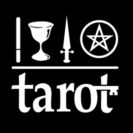Tarot Elemental Permutations improve divination
Using Elemental Dignities and paired tarot cards, the permutations of the fundamental attributions of the Tarot cards, the four elements, are more important than the divinatory meanings.
None of these meanings is considered “better” or “worse”, “stronger” or “weaker”. Try to avoid value judgements based on the description given in most Tarot books. This leaves us with the difficulty of how to assign prominence in a reading to a particular card.
Most Tarot spreads are exclusive, the antithesis of the spirit of Tarot which is essentially inclusive, harmonious and whole. Most Tarot spreads work by pre-defining a amount of positions and placing a Tarot card on each place. Thus we have a position for Past, Present, Future, Love, Work, Health etc. Since each position is defined simply in terms of language, the interpretation depends on trying to shoehorn the ‘meaning’ of a card to a group. In these circumstances, it is easy to simply use the groupings of Major, Minor and Court cards, which usually means that the Major cards have greater prominence than the others do.
However, there are sets of rules that govern the four elements when
they react between themselves. By understanding and applying these rules you will have a far deeper appreciation and understanding
of the dynamics of the cards that underlie a reading.
The elemental energies interact with each other like so:
Fire fire
Excessively active, explosive action.
Neutral, weak. Fire and Water cancel each other out.
Air feeds the Fire, intensely active while the energy lasts.
The passive Earth supports the active Fire.
The passive waters keep everything still.
The passive Water will settle below the Air without any energy from Fire, but there is no Earth to support either. An unstable situation.
Either the Earth supports Water, as in a cup or container, or the seabed, or Earth and Water combine to create a muddy situation.
Air is active but unstable, so when two combine we have ideas that change and mutate, but nothing is likely to get done.
Two passive Earths create a long-lasting solid foundation.
Air rises upwards, while Earth stays in the same place, so there is separation.
It is useful to compare this list with the previous list. For instance, Fire and Water are enemies whose energies cancel each other out into a stalemate, since the combination of Water and Earth is friendly and creates a situation that is strongly inertial.
Note that in Tarot, individual Court cards represent the interaction
of two elements, but in the context of the watery part OF Air, or fiery
part OF Fire. In general, Elemental Dignities only considers the dominant element, not the part, but you may consider the subtleties of the combinations (and they are very subtle).
If we speak in terms of Major, Minor and Court cards we are in a situation like that of a hierarchy where the Upper classes do not mix with the Lower classes. In contrast, with the elements there is a very strong level of interactivity. By combining the three tables we can begin to see the complexity of the various combinations, and you are able to make some judgements about the dynamics of the energies within Tarot without even considering the “meaning” of each card.
